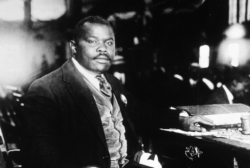
By Roger House
Marcus Garvey ignited one of the most phenomenal social movements in modern history and was admired around the world. Yet few today understand his quest to promote the economic and cultural advancement of Black people. As DEI falters, and Black Angelenos are forgotten by Trump, people may want to resurface the vision of Marcus Garvey.
In January, former President Biden’s posthumous pardon of Garvey created a moment to resurface the vision of the pan-African pioneer. President Trump’s efforts to dismantle inclusive policies in federal and corporate workplaces – and punish South Africa for reclaiming ancestral lands stolen by white settlers – provides new urgency for applying Garvey’s cooperative strategies to the challenges of today.
 Garvey came to the U.S. in 1916 during a period of reactionary politics in opposition to a growing Black urban migration. It was a time of mob lynching in the South, campaigns to deny housing and jobs in the North and hooligan riots to eliminate Black settlements in cities across the country. President Woodrow Wilson took steps to resegregate the federal workplace and erode the Black civil service even as he called on Black men to enlist during World War I.
Garvey came to the U.S. in 1916 during a period of reactionary politics in opposition to a growing Black urban migration. It was a time of mob lynching in the South, campaigns to deny housing and jobs in the North and hooligan riots to eliminate Black settlements in cities across the country. President Woodrow Wilson took steps to resegregate the federal workplace and erode the Black civil service even as he called on Black men to enlist during World War I.
In the midst of despair, Garvey found a way to lift the spirits of the urban folk by nurturing an affirming statement of Black pride and achievement. His organization, the Universal Negro Improvement Association (UNIA), advocated for Pan-African awareness and progress with the slogan “”Up, you mighty race, accomplish what you will.”
UNIA was centered in Harlem, with branches across the country and overseas. By 1920, it had grown to become the largest Black organization ever developed. It was not a civil rights group seeking integration — members viewed that agenda as impractical and potentially fatal — but an omnibus syndicate for self-help in the urban community. UNIA still exists today but the old organization is no longer central to implementing the cooperative vision of Garvey.
Economically, Garvey’s program went beyond small community outlets and appealed to UNIA members and the Black community to collectively invest in larger ventures. In 1920, for instance, he founded UNIA’s financial arm, the Negro Factories Corporation, to underwrite community enterprises. It was capitalized at $1 million through the sale of 200,000 shares of common stocks at $5 per share. Working-class people bought stock by combining savings, according to Juliet Walker’s book “The History of Black Business in America.”
The corporation invested in an array of companies to serve the needs of urban consumers, such as a textile factory in Harlem to make uniforms for UNIA members and dolls for Black children. It opened three grocery stores, two restaurants, a steam laundry and a printing press for the weekly “Negro World” newspaper, with a circulation of 200,000. UNIA owned modest clubhouses and encouraged branches to provide mutual aid to members in need, including small loans, death benefits and employment assistance. Such support was intended to counter the notion that people can only get by alone or through dependence on charity or the state.
It was a practice of cooperatively financed enterprise that can still be effective today. Most notably in areas with favorable conditions of Black statewide organization and accountable institutional practices. Rather than undue reliance on the Democratic Party agenda, Black social, political, and business leaders should look to devise pragmatic projects of self-help with community allies: Among the initiatives are sustained support of existing business and financial institutions and the creation of practical cooperative entities: multifamily housing, clinics and pharmacies, mobile grocery outlets, and tech apps to utilize delivery services, skilled laborers, and professionals.
Moreover, rather than the current individual approach to reparations, Black political leaders should focus on establishing a national development bank for the descendants of slavery and Jim Crow. It would be a central clearinghouse for reparations and donations and network with Black-owned banks and other community financial institutions to vet and underwrite worthy projects.
Culturally, Garvey was a master of the symbolic gesture and developed popular imagery, such as the red, black and green Pan-African flag. He used the political theater of parades and rallies to excite the imagination and attract many thousands of dues-paying members. His cry of “Africa for the Africans at home and abroad” was a counter to the colonization by European powers. However, the “Back to Africa” cry was intended more as a cultural and commercial activity rather than a migration to the continent.
In these times, as schools heed the call to eliminate DEI and Black history, Black educators and cultural creators need to devise alternative ways to inform the folk about the diasporic and African heritage. “Back to Africa” practically should mean a renewed emphasis on learning about the history and current affairs of the continent, travel as tourists, buy imported products, and support favorable trade, investment, and immigration policies.
To established leaders, Garvey’s ornate uniform and grandiose ambitions were dismissed as preposterous. What critics failed to appreciate was how he modeled the garb of the victorious 18th-century revolutionary leaders of Haiti. He adapted the military uniform of Jean Jacques Dessalines — the first leader of an independent Black republic — to create a spectacle of sovereignty. And when UNIA anointed Garvey as the “Provincial President of Africa,” it was no more audacious than when the Belgium King Leopold II claimed to be the founder and owner of the Congo!
Marcus Mosiah Garvey was born in Jamaica in 1887, then still under British rule. He left Jamaica in 1910 to work on the British-owned plantations and in London. According to the “Philosophy and Opinions of Marcus Garvey,” he was appalled at the abuse of Black workers, wondering, “Where is the Black man’s government? Where are his men of big affairs? I could not find them, and I will help to make them.”
He was inspired by Booker T. Washington’s memoir “Up from Slavery,” his development of a program of industrial education at Tuskegee Institute in Alabama, and support of Black towns and businesses through the National Negro Business League. Garvey hoped to start a similar school in Jamaica and established UNIA as the management arm. He was invited to visit Tuskegee but Washington passed away a few months before Garvey arrived in America.
During the trip, Garvey toured 38 states and was disenchanted with the racial conditions — but found the folk receptive to appeals for collective action. He opened a UNIA chapter in Harlem as urban migration fostered a cosmopolitan community, then expanded to 30 other cities.
In 1920, he hosted an international conference that drew 25,000 members to Madison Square Garden and issued the poignant “Declaration of Rights of the Negro Peoples of the World.” It demanded independence for Africa from European and Arab colonization and justice for Blacks of the diaspora. UNIA influenced the development of the African Orthodox Church, founded in 1921 to promote the reverence of Black deities.
During an earlier period of reactionary politics in America, Garvey created a movement that enabled Black people to be proud of their cultural heritage, engage in meaningful cooperative economics and embrace a common destiny for “Mother Africa.” As American institutions regress on equality under the Trump Administration, Garvey’s vision should be adapted to serve the needs of the diverse Black community today.
Roger House is professor emeritus of American Studies at Emerson College and the author of “Blue Smoke: The Recorded Journey of Big Bill Broonzy” and “South End Shout: Boston’s Forgotten Music Scene in the Jazz Age.” His forthcoming book is “Five Hundred Years of Black Self-Governance: A Call to Conscience.” A version of the commentary was published in The Hill.


